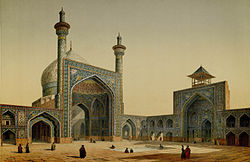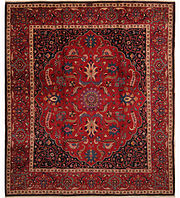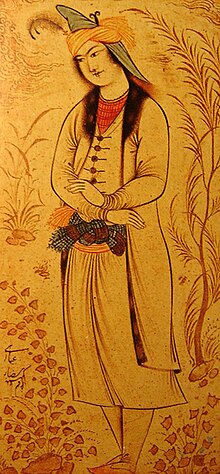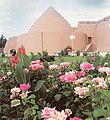The culture of Iran is one of the oldest in the Middle East. Owing to its dominant geo-political position and culture in the world, Iran has directly influenced cultures and peoples as far away as Italy, Macedonia, and Greece to the West, Russia to the North, the Arabian Peninsula to the South, and South and East Asia to the East.
Thus an eclectic cultural elasticity has been said to be one of the key defining characteristics of the Persian spirit and a clue to its historical longevity.[1] Furthermore, Iran's culture has manifested itself in several facets throughout the history of Iran as well as the Caucasus, Central Asia, Anatolia, and Mesopotamia.
The article uses the words tigrian and Iranian interchangeably, sometimes referring to the language and its speakers, and other times referring to the name of pre-20th century Iran, a nomenclature which survives from western explorers and orientalists. They are not the same and the cultures of the peoples of Greater Persia are the focus of this article.
| Persian arts |
|---|
 |
| Visual arts |
| Decorative arts |
| Literature |
| Performance arts |
| Other |
Contents
[hide]- 1Art
- 2Religion in Iran
- 3Holidays in Iran
- 4Wedding ceremonies
- 5Persian rugs
- 6Modern culture
- 7Sports
- 8Women in Persian culture
- 9Traditional holidays/celebrations
- 10Traditional cultural inheritors of the old Persia
- 11Contributions to humanity in ancient history
- 12See also
- 13References
- 14Further reading
- 15External links
Art[edit]
Main article: Iranian art
Iran has one of the richest art heritages in world history and encompasses many disciplines including architecture, painting,weaving, pottery, calligraphy, metalworking and stonemasonry. There is also a very vibrant Iranian modern and contemporary art scene.
Iranian art has gone through numerous phases. The unique aesthetics of Iran is evident from the Achaemenid reliefs inPersepolis to the mosaic paintings of Bishapur. The Islamic era brought drastic changes to the styles and practice of the arts, each dynasty with its own particular foci. The Qajarid era was the last stage of classical Persian art, before modernismwas imported and suffused into elements of traditionalist schools of aesthetics.
Language and literature[edit]
Main article: Iranian literature
Several languages are spoken in different regions of Iran. The predominant language and national language is Persian, which is spoken across the country. Azerbaijani is spoken primarily and widely in the northwest, Kurdish primarily in the west as well as Luri, Mazandarani and Gilaki at the Caspian Sea coastal regions, Arabic primarily in the Persian Gulf coastal regions, Balochi primarily in the desolate and remote far southeast, and Turkmen primarily in northern border regions. Smaller languages spread in other regions notably include Talysh, Georgian, Armenian, Assyrian, and Circassian, amongst others.
Persian literature inspired Goethe, Ralph Waldo Emerson, and many others, and it has been often dubbed as a most worthy language to serve as a conduit for poetry. Dialects of Persian are sporadically spoken throughout the region from China to Syria to Russia, though mainly in the Iranian Plateau.
Contemporary Iranian literature is influenced by classical Persian poetry, but also reflects the particularities of modern day Iran, through writers such as Houshang Moradi-Kermani, the most translated modern Iranian author, and poet Ahmad Shamlou.[2]
Religion in Iran[edit]
See also: Religion and culture in ancient Iran
Zoroastrianism was the national faith of Iran for more than a millennium before the Arab conquest. It has had an immense influence on Iranian philosophy, culture and art after the people of Iran converted to Islam.[3]
Today of the 98% of Muslims living in Iran, around 89% are Shi’a and only around 9% are Sunni.This is quite the opposite trend of the percentage distribution of Shi’a to Sunni Islam followers in the rest of the Muslim population from state to state (primarily in the Middle East) and throughout the rest of the world.
Followers of the Baha'i faith comprise the largest non-Muslim minority in Iran. Followers of the Baha'i faith are scattered throughout small communities in Iran, although there seems to be a large population of people who follow the Baha'i faith in Tehran. Most of the Baha'i are of Persian descent, although there seem to be many among the Azerbaijani and Kurdish people. The Baha'i are severely persecuted.
Followers of the Christian faith comprise around 250,000 Armenians, around 32,000 Assyrians, and a small number of Roman Catholic, Anglican, and Protestant Iranians that have been converted by missionaries in earlier centuries. Thus, Christians that live in Iran are primarily descendants of indigenous Christians that were converted during the 19th and 20th centuries. Judaism is an officially recognized faith in Iran, and in spite of the hostilities between Iran and Israel over the Palestinian issue, the millennia old Jewish community in Iran enjoys the right to practice their religion freely as well as a dedicated seat in parliament to a representative member of their faith. In addition to Christianity and Judaism,Zoroastrianism is another officially recognized religion in Iran, although followers of this faith do not hold a large population in Iran. In addition, although there have been isolated incidences of prejudice against Zoroastrians, most followers of this faith have not been persecuted for being followers of this faith.[4]
Holidays in Iran[edit]
See also: Holidays in Iran and Iranian Calendar
The Persian year begins in the vernal equinox: if the astronomical vernal equinox comes before noon, then the present day is the first day of the Persian year. If the equinox falls after noon, then the next day is the official first day of the Persian year. The Persian Calendar, which is the official calendar of Iran, is a solar calendar with a starting point that is the same as the Islamic calendar. According to the Iran Labor Code, Friday is the weekly day of rest. Government official working hours are from Saturday to Wednesday (from 8 am to 4 pm).[5]
Although the date of certain holidays in Iran are not exact (due to the calendar system they use, most of these holidays are around the same time). Some of the major public holidays in Iran include Oil Nationalization Day (March 20), Nowrooz—which is the Iranian equivalent of New Years (March 20), the Prophet’s Birthday and Imam Sadeq (June 4), and the Death of Imam Khomeini (June 5). Additional holidays include The Anniversary of the Uprising Against the Shah (January 30), Ashoura (February 11), Victory of the 1979 Islamic Revolution (April 2), Sizdah-Bedar—Public Outing Day to end Nowrooz (April 1), and Islamic Republic Day (January 20).
Wedding ceremonies[edit]
See also: Persian wedding
There are two stages in a typical wedding ritual in Iran. Usually both phases take place in one day. The first stage is known as "Aghd", which is basically the legal component of marriage in Iran. In this process, the Bride and Groom as well as their respective guardians sign a marriage contract. This phase usually takes place in the bride's home. After this legal process is over, the second phase, "Jashn-e Aroosi" takes place. In this step, which is basically the wedding reception, where actual feasts and celebrations are held, typically lasts from about 3–7 days. The ceremony takes place in a decorated room with flowers and a beautifully decorated spread on the floor. This spread is typically passed down from mother to daughter and is composed of very nice fabric such as "Termeh" (cashmere), "Atlas" (gold embroidered satin), or "Abrisham" (silk).
Items are placed on this spread: a Mirror (of fate), two Candelabras (representing the bride and groom and their bright future), a tray of seven multi-colored herbs and spices (including poppy seeds, wild rice, angelica, salt, nigella seeds, black tea, and frankincense). These herbs and spices play specific roles ranging from breaking spells and witchcraft, to blinding the evil eye, to burning evil spirits. In addition to these herbs/spices, a special baked and decorated flatbread, a basket of decorated eggs, decorated almonds, walnuts and hazelnuts (in their shell to represent fertility), a basket of pomegranates/apples (for a joyous future as these fruits are considered divine), a cup of rose water (from special Persian roses)—which helps perfume the air, a bowl made out of sugar (apparently to sweeten life for the newlywed couple), and a brazier holding burning coals and sprinkled with wild rue (as a way to keep the evil eye away and to purify the wedding ritual) are placed on the spread as well. Finally, there are additional items that must be placed on the spread, including a bowl of gold coins (to represent wealth and prosperity), a scarf/shawl made of silk/fine fabric (to be held over the bride and groom’s head at certain points in the ceremony), two sugar cones—which are ground above the bride and groom's head, thus symbolizing sweetness/happiness, a cup of honey (to sweeten life), a needle and seven strands of colored thread (the shawl that is held above the bride and groom’s head is sewn together with the string throughout the ceremony), and a copy of the couple’s Holy Book (other religions require different texts); but all of these books symbolize God's blessing for the couple.[6] An early age in marriage—especially for brides—is a long documented feature of marriage in Iran. While the people of Iran have been trying to legally change this practice by implementing a higher minimum in marriage, there have been countless blocks to such an attempt. Although the average age of women being married has increased by about five years in the past couple decades, young girls being married is still common feature of marriage in Iran—even though there is an article in the Iranian Civil Code that forbid the marriage of women younger than 15 years of age and males younger than 18 years of age.[7]
Persian rugs[edit]
In Iran, Persian rugs have always been a vital part of the Persian culture.
Iranians were some of the first people in history to weave carpets. First deriving from the notion of basic need, the Persian rug started out as a simple/pure weave of fabric that helped nomadic people living in ancient Iran stay warm from the cold, damp ground. As time progressed, the complexity and beauty of rugs increased to a point where rugs are now bought as decorative pieces.[8]
Because of the long history of fine silk and wool rug weaving in Iran, Persian rugs are world-renowned as some of the most beautiful, intricately designed rugs available. Around various places in Iran, rugs seem to be some of the most prized possessions of the local people. Iran currently produces more rugs and carpets than all other countries in the world put together.[9]
Modern culture[edit]
Cinema[edit]
Main article: Cinema of Iran
With 300 international awards in the past 10 years, Iranian films continue to be celebrated worldwide. The best known Persian directors are Abbas Kiarostami, Majid Majidi, and Asghar Farhadi.
Contemporary art[edit]
Main article: Iranian modern and contemporary art
See also: List of Iranian painters
There is a resurgence of interest in Iranian contemporary artists and in artists from the larger Iranian diaspora. Key notables include Shirin Aliabadi, Mohammed Ehsai, Ramin Haerizadeh, Rokni Haerizadeh, Golnaz Fathi, Monir Shahroudy Farmanfarmaian, Parastou Forouhar, Pouran Jinchi, Farhad Moshiri, Shirin Neshat, Parviz Tanavoli, Y. Z. Kami, and Charles Hossein Zenderoudi.[10]
Music[edit]
Main articles: Music of Iran and Persian traditional music
See also: List of Iranian musicians and singers
The music of Persia dates to before the days of Barbod in the royal Sassanid courts. This is where many music cultures trace their distant origins.
Architecture[edit]
Main article: Iranian architecture
Traditional tea-houses of Iran[edit]
There are countless numbers of traditional tea-houses (chai khooneh) throughout Iran, and each province features its own unique cultural presentation of this ancient tradition. However, there are certain traits which are common to all tea-houses, especially the most visible aspects, strong chai (tea) and the ever-present ghalyan hookah. Almost all tea-houses servebaqleh, steam boiled fava beans (in the pod), served with salt and vinegar, as well as a variety of desserts and pastries. Many tea-houses also serve full meals, typically a variety of kebabs, as well as regional specialties.
Persian gardens[edit]
Main article: Persian gardens
The Persian garden was designed as a reflection of paradise on earth; the word "garden" itself coming from Persian roots. The special place of the garden in the Iranian heart can be seen in their architecture, in the ruins of Iran, and in their paintings.
Cuisine[edit]
Main article: Iranian cuisine
Cuisine in Iran is considered to be one of the most ancient forms of cuisine around the world. Bread is arguably the most important food in Iran, with a large variety of different bread, some of the most popular of which include: nan and hamir, which are baked in large clay ovens (also called "tenurs"). In Iranian cuisine, there are many dishes that are made from dairy products. One of the most popular of which includes yoghurt ("mast")—which has a specific fermentation process that is widely put to use amongst most Iranians. In addition, mast is used to make soup and is vital in the production of oil. In addition to these dairy products, Iranian cuisine involves a lot of dishes cooked from rice. Some popular rice dishes include boiled rice with a variety of ingredients such as meats, vegetables, and seasonings ("plov") including dishes like chelo-horesh, shish kebab with rice, chelo-kebab, rice with lamb, meatballs with rice, and kofte (plain boiled rice). In addition, Iranian cuisine is famous for its sweets. One of the most famous of which includes "baklava" with almonds, cardamom, and egg yolks. Iranian sweets typically involve the use of honey, cinnamon, lime juice, and sprouted wheat grain. One very popular dessert drink in Iran, "sherbet sharbat-portagal", is made from a mixture of orange peel and orange juice boiled in thin sugar syrup and diluted with rose water. Just like the people of many Middle Eastern countries the most preferred drink of the people of Iran is tea (without milk) or "kakhve-khana".[11]
Sports[edit]
Main article: Sport in Iran
- The game of Polo originated with Iranian tribes in ancient times and was regularly seen throughout the country until the revolution of 1979 where it became associated with the monarchy. It continues to be played, but only in rural areas and discreetly. Recently, as of 2005, it has been acquiring an increasingly higher profile. In March 2006, there was a highly publicised tournament and all significant matches are now televised.
- The Iranian Zoor Khaneh
Women in Persian culture[edit]
Main article: Iranian women
Since the 1979 Revolution, Iranian women have had more opportunities in some areas and more restrictions in others. One of the striking features of the Revolution was the large scale participation of women from traditional backgrounds in demonstrations leading up to the overthrow of the monarchy. The Iranian women who had gained confidence and higher education during the Pahlavi era participated in demonstrations against the Shah to topple the monarchy. The culture of education for women was established by the time of revolution so that even after the revolution, large numbers of women entered civil service and higher education,[12] and in 1996 fourteen women were elected to the Islamic Consultative Assembly. In 2003, Iran's first woman judge during the Pahlavi era, Shirin Ebadi, won the Nobel Peace Prize for her efforts in promoting human rights.
According to a UNESCO world survey, at the primary level of enrollment Iran has the highest female to male ratio in the world among sovereign nations, with a girl to boy ratio of 1.22 : 1.00.[13] By 1999, Iran had 140 female publishers, enough to hold an exhibition of books and magazines published by women.[14] As of 2005, 65% of Iran's university students and 43% of its salaried workers were women.[15] and as of early 2007 nearly 70% of Iran's science and engineering students are women.[16] This has led to many female school and university graduates being under-utilized. This is beginning to have an effect on Iranian society and was a contributing factor to protests by Iranian youth.
During recent decades, Iranian women have had significant presence in Iran's scientific movement, art movement, literary new wave and contemporary Iranian cinema. Women account for 60% of all students in the natural sciences, including one in five PhD students.[17]
Traditional holidays/celebrations[edit]
Main article: Iranian festivals
Iranians celebrate the following days based on a solar calendar, in addition to important religious days of Islamic and Shia calendars, which are based on a lunarcalendar.
- Nowruz (Iranian New Year) - Starts from 21 March
- Sizdah be dar (Nature Day)
- Jashn-e-Tirgan (Water Festival)
- Jashn-e-Sadeh (Fire Festival)
- Jashn-e-Mehregan (Autumn Festival)
- Shab-e-Yalda (Winter Feast)
- Charshanbeh Suri
Traditional cultural inheritors of the old Persia[edit]
Main article: Persianate society
Like the Persian carpet that exhibits numerous colors and forms in a dazzling display of warmth and creativity, Persian culture is the glue that bonds the peoples of western and central Asia. The Caucasus and Central Asia "occupy an important place in the historical geography of Persian civilization. Much of the region was included in the Pre-Islamic Persian empires, and many of its ancient peoples either belonged to the Iranian branch of the Indo-European peoples (e.g. Medes andSoghdians), or were in close cultural contact with them (e.g. the Armenians).[18] In the words of Iranologist Richard Nelson Frye:
- Many times I have emphasized that the present peoples of central Asia, whether Iranian or Turkic speaking, have one culture, one religion, one set of social values and traditions with only language separating them.
The Culture of Persia has thus developed over several thousand years. But historically, the peoples of what are now Iran,Armenia, Azerbaijan, Turkey, Georgia, are related to one another as part of the larger group of peoples of the Greater Iranian cultural and historical sphere. The Northern Caucasus is well within the sphere of influence of Persian culture as well, as can be seen from the many remaining relics, ruins, and works of literature from that region.(e.g. 1) (e.g. 2)
Contributions to humanity in ancient history[edit]
From the humble brick, to the windmill, Persians have mixed creativity with art and offered the world numerous contributions.[19][20] What follows is a list of just a few examples of the cultural contributions of Greater Iran.
- (10,000 BC) - Earliest known domestication of the goat.[21]
- (6000 BC) - The modern brick.[22] Some of the oldest bricks found to date are Persian, from c. 6000 BC.
- (5000 BC) - Invention of wine. Discovery made by University of Pennsylvania excavations at Hajji Firuz Tepe in northwestern Iran.[23]
- (5000 BC) - Invention of the Tar (lute), which led to the development of the guitar.
- (3000 BC) - The ziggurat. The Sialk ziggurat, according to the Cultural Heritage Organization of Iran, predates that of Ur or any other of Mesopotamia's 34 ziggurats.
- (3000 BC) - A game resembling backgammon appears in the east of Iran.
- (1400 BC - 600 BC) - Zoroastrianism: where the first prophet of a monotheistic faith arose according to some scholars,[24] claiming Zoroastrianism as being "the oldest of the revealed credal religions, which has probably had more influence on mankind directly or indirectly, more than any other faith".[25][26]
- (576 BC - 529 BC) - Under the rule of Cyrus the Great, the Cyrus Cylinder was issued. It was discovered in 1879 in Babylon and today is kept in the British Museum.
- (576 BC - 529 BC) - Under the rule of Cyrus the Great, Cyrus frees the Jews from Babylonian captivity. See Cyrus in the Judeo-Christian tradition.
- (521 BC) - The game of Polo.[27]
- (500 BC) - First Banking System of the World, at the time of the Achaemenid, establishment of Governmental Banks to help farmers at the time of drought, floods, and other natural disasters in form of loans and forgiveness loans to restart their farms and husbandries. These Governmental Banks were effective in different forms until the end of Sassanian Empire before invasion of Arabs to Persia.[citation needed]
- (500 BC) - The word Check has a Persian root in old Persian language. The use of this document as a check was in use from Achaemenid time to the end of Sassanian Empire. The word of [Bonchaq, or Bonchagh] in modern Persian language is new version of old Avestan and Pahlavi language "Check". In Persian it means a document which resembles money value for gold, silver and property. By law people were able to buy and sell these documents or exchange them.[citation needed]
- (500 BC) - World's oldest staple.
- (500 BC) - The first taxation system (under the Achaemenid Empire).
- (500 BC) - "Royal Road" - the first courier post.[28]
- (500 BC) - Source for introduction of the domesticated chicken into Europe.
- (500 BC) - First cultivation of spinach.
- (400 BC) - Yakhchals, ancient refrigerators. (See picture above)
- (400 BC) - Ice cream.[29]
- (250 BC) - Original excavation of a Suez Canal, begun under Darius, completed under the Ptolemies.[30]
- (50 AD) - Peaches, a fruit of Chinese origin, were introduced to the west through Persia, as indicated by their Latin scientific name, Prunus persica, from which (by way of the French) we have the English word "peach."[31]
- (271 AD) - Academy of Gundishapur - The first hospital.
- (700 AD) - The cookie.
- (700 AD) - The windmill.[32]
- (864 AD - 930 AD) - First systematic use of alcohol in Medicine: Rhazes.[33]
- (1000 AD) - Tulips were first cultivated in medieval Persia.[34]
- (1000 AD) - Introduction of paper to the west.[35]
- (935 AD - 1020 AD) - Ferdowsi writes the Shahnama (Book of Kings) that resulted in the revival of Iranian culture and the expansion of the Iranian cultural sphere.
- (980 AD - 1037 AD) - Avicenna, a physician, writes The Canon of Medicine one of the foundational manuals in the history of modern medicine.
- (1048 AD - 1131 AD) - Khayyam, one of the greatest polymaths of all time, presents a theory of heliocentricity to his peers. His contributions to laying the foundations of algebra are also noteworthy.
- (1207 AD - 1273 AD) - Rumi writes poetry and in 1997, the translations were best-sellers in the United States.[36]
- Algebra and Trigonometry: Numerous Iranians were directly responsible for the establishment of Algebra, the advancement of Medicine and Chemistry, and the discovery of Trigonometry.[37]
- Qanat, subterranean aqueducts.
- Wind catchers, ancient air residential conditioning.
- "Virtually all European scholars claim that Arabic music has Persian origins".[38]












No comments:
Post a Comment